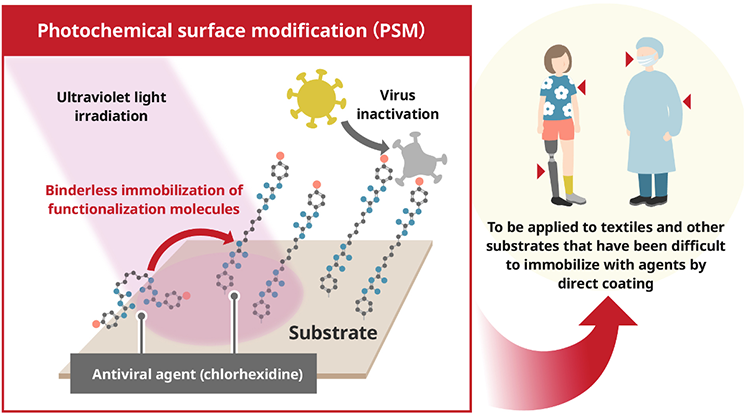Researchers) NAKAMURA Takako, Deputy Director, Research Institute for Advanced Electronics and Photonics, AKEDO Jun, Prime Senior Researcher, Device Technology Research Institute, YAMADA Yoichi, Associate Professor, Shujitsu University
- Development of fast and direct immobilizing technology that does not require heating
- Antiviral effect lasted for 2 months with fixed chlorhexidine.
- Applicable to masks, general clothing, medical textile components, and orthotics

Development of antiviral nanocoating technology
The demand for antiviral coatings is increasing due to COVID-19 and other factors. However, antiviral agent coatings generally have restrictions on their substrates, namely, in the case of direct immobilization of photocatalysts or sol-gel methods without any binders, the substrates need to be glass or ceramic. Conventional technologies for coating antiviral agents on substrates using binder agents, adhesives, or plasma treatment may damage the substrate, affect the design, and limit the surface chemical structure of the substrate.
Researchers at AIST, in collaboration with Shujitsu University, have developed a fast and direct coating technology of antiviral components on a wide range of substrates, from sheets to textiles.
The demand for antiviral coatings is increasing due to COVID-19 and other influences. However, conventional coating technologies are limited by the physicochemical properties of the surface, which can lead to chemical and/or physical damages to the substrates. The newly developed surface functionalization technology using photochemical surface modification (PSM) enables direct chemical modification (chemical immobilization) on the substrate surface while maintaining the chemical structure of the molecules under mild conditions. This technology enables fast and direct coating of antiviral agents. The results of demonstration tests have confirmed that the inactivation effect against influenza viruses lasts for two months.
This technology can be applied directly to a wide range of materials, from sheets to textiles. Since the antiviral effect is expressed without elution of the agent, it can be safely used in applications where the coating is in contact with mucous membranes or wounds for a long time. In the future, this technology is expected to be applied to textile coatings such as masks and medical gowns, and to building materials such as wallpaper.